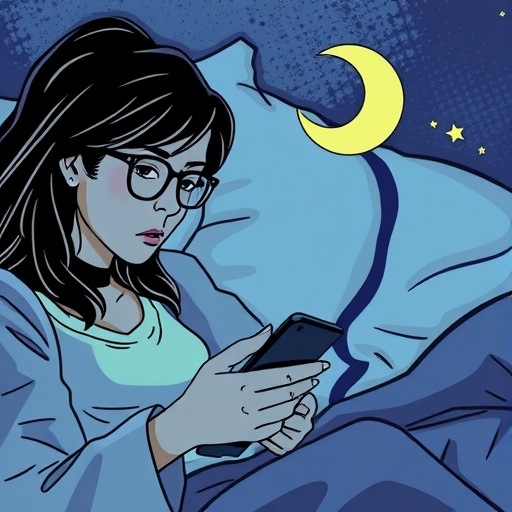In the ever-evolving landscape of digital technology, recent research has unearthed a compelling connection between circadian rhythms and problematic technology use in young adults. A pioneering study conducted collaboratively by the University of Portsmouth and the University of Surrey delves deep into why so-called “night owls” — individuals with a natural preference for late-night activity — are disproportionately at risk of developing smartphone and social media addictions. Far beyond the simplistic association of screen time, this work illuminates the intricate psychological pathways that place evening-type individuals in a perilous cycle of anxiety, loneliness, and compulsive technology use.
The concept of circadian preference, or chronotype, categorizes individuals based on their natural sleep-wake tendencies. Evening types, popularly known as “night owls,” tend to stay awake late into the night and wake up later in the morning, misaligned with the conventional societal schedule. This discordance often leads to a phenomenon called “social jet lag,” where individuals’ biological clocks are out of sync with social demands. The recent study proposes that this misalignment may underlie the heightened vulnerability of night owls to problematic smartphone and social media behavior.
Problematic smartphone use (PSU) goes well beyond anecdotal excessive use, being characterized by symptoms akin to behavioral addiction. These include heightened anxiety when separated from one’s device, neglect of important daily responsibilities, and compulsive checking of notifications. Social media addiction carries similar hallmarks: uncontrolled, excessive engagement that disrupts normal life functioning. Alarmingly, recent surveys estimate that nearly 40% of UK university students exhibit symptoms indicative of social media addiction, with female students being particularly susceptible.
While prior research indicated a link between eveningness and adverse outcomes such as poor sleep quality, increased depressive symptoms, and addictive tendencies, the mechanisms fueling this association remained unclear. The groundbreaking study, which surveyed more than 400 young adults aged 18 to 25, employed validated psychometric tools to uncover the interplay between circadian preference and problematic technology use. It revealed loneliness and anxiety as pivotal mediators that spur young night owls to seek solace in their smartphones and social media platforms.
The researchers describe a self-perpetuating vicious cycle: night owls often find themselves socially desynchronized, as their peak active hours clash with those of the broader population. This misalignment fosters emotional discomfort, manifesting as loneliness and heightened anxiety. To cope, these young adults gravitate toward their devices, which temporarily dull emotional pain but ultimately exacerbate distress by deepening isolation and anxiety.
Dr. Anna-Stiina Wallinheimo, a key investigator from the University of Portsmouth’s School of Psychology, Sport, and Health Sciences, emphasizes the emotional underpinnings of this phenomenon. She highlights that technology is not simply an easily accessible diversion but often a maladaptive coping mechanism employed to soothe emotional turmoil. “The tragic irony here is that the very tools intended as social connectors frequently intensify feelings of loneliness and anxiety for young night owls,” she explains.
This research contributes a critical gap in the digital well-being literature by elucidating emotional variables—primarily loneliness—that mediate circadian preference and problematic technology engagement. The findings suggest that interventions aimed solely at reducing screen time may be superficial unless they concurrently address the root emotional drivers compelling usage. This insight shifts the paradigm toward more targeted mental health strategies tailored to circadian typologies.
Co-author Dr. Simon Evans from the University of Surrey underscores the importance of addressing the underlying emotional distress, particularly during late evenings when societal support systems—such as counseling services—are less accessible. Evening hours, he notes, can be especially fraught for young adults grappling with social isolation, demanding bespoke strategies to manage loneliness and anxiety that do not rely on further screen engagement.
The implications of these findings are profound amid the escalating mental health crisis among young people. Rising rates of anxiety, depression, and social withdrawal threaten to compromise academic attainment and overall quality of life. By recognizing the intertwined roles of circadian biology, emotional well-being, and technology use, health professionals and educators can design more effective prevention and intervention programs.
Researchers advocate for increased awareness campaigns to help young evening-type individuals recognize how their sleep preferences and emotional challenges intertwine to raise their risk of problematic technology use. Enhancing understanding could empower these individuals to seek healthier emotional outlets rather than defaulting to smartphones and social media, which compound emotional distress in the long term.
Moreover, the study suggests that educational institutions and mental health services consider circadian typology when developing support systems for students. Tailored outreach during evening hours, accessible virtual support groups, and coping skills training could mitigate loneliness and anxiety, disrupting the cyclical reliance on digital devices for emotional relief.
In conclusion, this pioneering survey-based research fortifies the argument that problematic technology use among young adults is a multifaceted issue, intimately connected to individual biological rhythms and emotional health. The revelation that loneliness and anxiety serve as primary psychological channels between circadian preference and addictive device behavior signals a pressing need for nuanced interventions. By embracing this complexity, society can better confront the challenges of digital addiction and foster healthier relationships with technology among night owls and the wider youth population alike.
The full study, titled “Mechanisms that link circadian preference to problematic smartphone and social media use in young adults,” is published in PLOS One and serves as a vital resource for mental health practitioners, educators, and policymakers aiming to curb the tide of smartphone and social media addiction among vulnerable youth.
Subject of Research: People
Article Title: Mechanisms that link circadian preference to problematic smartphone and social media use in young adults
News Publication Date: 12-Sep-2025
Web References:
- PLOS One Article
- University of Portsmouth Research
References:
Wallinheimo, A.-S., Evans, S., et al. (2025). Mechanisms that link circadian preference to problematic smartphone and social media use in young adults. PLOS One. https://doi.org/10.1371/journal.pone.0331961
Keywords: Behavioral psychology, Neuroscience, Circadian rhythms, Anxiety, Loneliness, Smartphone addiction, Social media addiction, Young adults, Mental health, Chronotype




